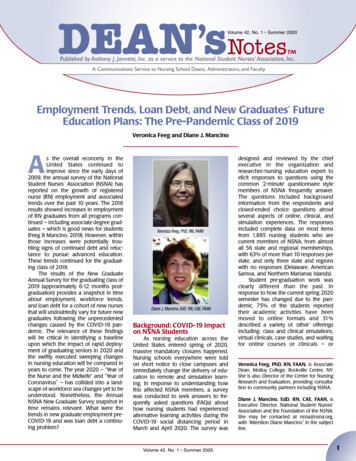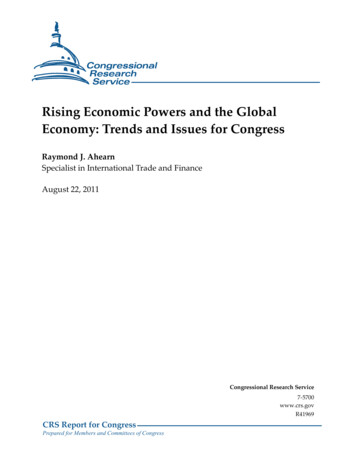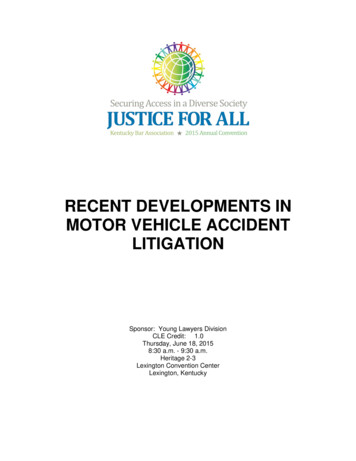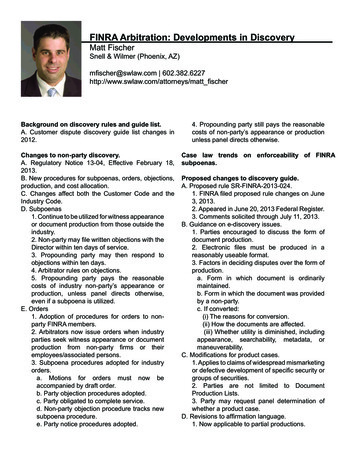
Transcription
GLOBAL EMPLOYMENTTRENDS AND DEVELOPMENTSKaren Bock, Partner, TorontoHelen Colquhoun, Partner, Hong KongUte Krudewagen, Partner, Silicon ValleyKate Lucente, Associate, SeattleMaria Rodriguez, Partner, Los AngelesSandra Wallace, Partner, London*This presentation is offered for informational purposes only, and the contentshould not be construed as legal advice on any matter.www.dlapiper.comGlobal Employment Trends and Developments0
Agenda1. Top recent and future global employment law developments2. Contingent workers3. A step by step guide to GDPR implementation across the EU with afocus on HR data4. Employment background checks5. Social mediawww.dlapiper.comGlobal Employment Trends and Developments1
TOP RECENT AND FUTUREGLOBAL EMPLOYMENT LAWDEVELOPMENTSwww.dlapiper.comGlobal Employment Trends and Developments2
Trends and themesShifting politicallandscape /labour reformData privacyWorker statusWorking timeGlobal mobilityGenderequalityTrade secretsOther notablelocal comGlobal Employment Trends and Developments3
Shifting political landscape/labour reformEuropeUK: BrexitFR: MacronNL/DE/AT/CZ: Impact of elections?PL: New labour codeElsewhereBR: Temer reformMX: Litigation reformsCA: Sweeping changes to Ontario EmploymentStandards and Labour Relations Lawwww.dlapiper.comGlobal Employment Trends and Developments4
Data privacyEU-wide General Data Protection Regulation in force May 25, 2018 Fines of up to 20 million or 4% annual turnover Article 29 guidance on employee monitoringUS – EU transfers Privacy shield replaced safe harborElsewhere CN: New cyber security laws from June 2017 ZA: POPI in force 2018 SG: Significant changes expectedwww.dlapiper.comGlobal Employment Trends and Developments5
Worker statusUK:Taylor Review and UK Government reviews on worker status and tax/social security treatmentfor contingent workersMultiple cases in the employment courts including Uber Employment Appeal Tribunal(September 2017)UK Supreme Court due to hear worker status arguments in February 2018 (Pimlico Plumbersand possibly Uber if further appealed)Elsewhere:European Pillar of Social Rights/ILO Global Commission on worker statusDE: new tighter labour leasing rules from April 2017NL: contractor tax rules under reviewCA: closer scrutiny of contractor status by gov't agencies in Ontario; amendment ofemployment standards laws to add protection for part-time, casual and temp agency staffTest cases likely elsewherewww.dlapiper.comGlobal Employment Trends and Developments6
Working timeRight to disconnect FR: The real storyNew remote/flexible working laws IT, ROMPaid leave CA: Additional week of statutory vacation will be requiredfor employees with 5 years' service UK holiday pay DK: Proposed changes to holiday accrual for new joinerswww.dlapiper.comGlobal Employment Trends and Developments7
Global mobilityEU-widePosted Workers Enforcement Directive implemented across the EU during2016/17 applies to EU workers posted temporarily to another EU state. Checkfor local requirements, e.g. requirement to notify labour authorities in advanceUKImpact of Brexit on EU nationals in the UK and vice versa"Right to work" checks for job applicants (civil and criminal penalties possible fornon-compliance)MiddleEastNationalisation programesChinaNew rules on expat work permitsAustraliaMajor change to 457 visa programwww.dlapiper.comGlobal Employment Trends and Developments8
Gender equalityGender payQuotasReporting DE: Gender paytransparency rulesfrom 1 July 2017apply where 200 employees UK: Mandatorygender pay reportingfrom April 2017where 250 employees NL: Proposal ongender paytransparency SE: Annual salarysurveys EU: Directiveproposed on genderbalance on companyboards AT: New quota forfemale boardmembers SE: 25 employees,equality planrequired every year FI: 30 employees,non-discriminationplan by 31 Dec 2016www.dlapiper.comGlobal Employment Trends and Developments9
Anti-corruption/ whistleblowingEU-wideFRNLNOElsewhere EuropeanCommissionpublicconsultation New EU widerules? 50 employees Policy to bein place by 1January 2018 July 2016 50 employees Written policyrequired July 2017 5 employees Written policyrequired IT:Discussionsin parliament AU: USbounty stylesystem inpipeline RU:Proposednew lawswww.dlapiper.comGlobal Employment Trends and Developments10
Transparency in supply chainsUK Modern Slavery Act implementedin 2015 (based on CA legislation) Applies if global turnover 36million and supply goods orservices to or from the UK Annual website statement to bepublished within 6 months offiscal year end – all in scopebusinesses will need to publishduring 2017 Limited enforcement powers;focus on public/consumer scrutinyinsteadwww.dlapiper.comAU Consultation paper issued inAugust 2017 on Modern Slaveryin supply chains reportingrequirements Likely to be introduced in 2018Global Employment Trends and Developments11
Trade secrets EU Trade Secrets Directive In force summer 2018 Harmonising protection and enforcement of trade secrets across the EU Watch for local implementation Opportunity to review IP provisions/covenants?www.dlapiper.comGlobal Employment Trends and Developments12
Other notable local changesEU-wideBarbelescu v Romania: Employer was not permitted to fire employee for sending(prohibited) private messages on a work system Employers must make itCLEAR in advance that monitoring is taking place Restrictions on privateuse/monitoring must be proportionatePLNew mandatory employer pension schemes – in force 2018? Labour codereform in 2019? Electronic storage of employment docs possible – from 2019 orsooner? New retirement ages 65 (men) and 60 (women); NOTE: protectionfrom dismissal for 4 years preceding retirementITNew trigger for disabled employee quota Contracting with directorsRONew penalties for failure to provide written employment documentsUKEmployment Tribunal fees abolished by Supreme Court immediate uptick inemployee claimswww.dlapiper.comGlobal Employment Trends and Developments13
Other notable local changesHKEnd of MPF offset? Proposal to allow tribunals to orderreinstatement of employee without consent whereunreasonable/unlawful dismissal – leverage for higherdamagers?TWChanges to Labour Standards Act are expected by endof 2017 to increase flexibility particularly aroundovertime, weekly time off and annual leaveINIncrease in paid maternity leave to 6 months crèchefacility mandatory if 50 employeeswww.dlapiper.comGlobal Employment Trends and Developments14
CONTINGENT WORKERSStrategies to minimise the risk of getting it wrongwww.dlapiper.comGlobal Employment Trends and Developments15
yourSpaceLOGIN to yourSpaceThe training you want,with the trainer you want,when you want it,in your space*.Access the hottest personal trainers in your area.Swipe right when you find a trainer who matches your needs.Tell us where you are, when you want to be trained and we will do the rest.*currently available in London, Paris, Frankfurt, Toronto, Vancouver, Los Angeles, San Francisco and Hong Kong.All our trainers have world class fitness credentials and are fully qualified in the patented yourSpace fitness method.www.dlapiper.comGlobal Employment Trends and Developments16
You are yourSpace's first in-house legal counsel.These are your instructions Background: HQ’d in the UK; founder and CEO is Caitlin Brown, a fitness tech entrepreneur Recently launched and about to receive new funding to engage more PTs New PTs attend an induction in the yS methodology delivered by a team of supertrainers (based in Warsaw) who travel to yS locations to deliver trainingCB wants you to advise on how yS should engage the PTs worldwide. CBwants a model that:1. Guarantees PT quality and availability2. Provides flexibility; work depends on user demand3. Recognises the investment made in training the PTs by tying the PTs in for aperiod of time4. Restrains the PTs from working in other gyms/fitness businesses whileworking for yS (they can do other jobs as long as they don't work as PTs) andfor as long as possible afterwards5. Avoids significant legal, financial or reputational exposure. CB wants yS to bea fitness business that new and upcoming PTs want to work forwww.dlapiper.comGlobal Employment Trends and Developments17
How would you advise Caitlin?Status optionsRisk foryourSpace?Employed (zero hours/part-time/full time/permanent/fixed term)High - med low/no risk?Self-employed/independent contractorsHigh - med low/no risk?Worker (UK type model with some rights e.g. holiday,whistleblowing protection, etc. but not full employmentprotection)High - med low/no risk?Temporary agency worker (supplied via third party agency)High - med low/no risk?Franchise modelHigh - med low/no risk?Engage business to supply and manage the PTs underyourSpace standards: "managed service" modelHigh - med low/no risk?www.dlapiper.comGlobal Employment Trends and Developments18
Possible challenges, possible solutions Misclassification/reclassificationJoint employmentConcealed workAntifronting representation riskOtherwww.dlapiper.comGlobal Employment Trends and Developments19
GDPR IMPLEMENTATIONGUIDE: SPOTLIGHT ON HRDATAwww.dlapiper.comGlobal Employment Trends and Developments20
GDPR represents a major changeFrom May 25, 2018, GDPR will applyto every company handling personaldata within the EU, transferring datainto and out of the EU, and mayapply to processing of EU dataanywhere in the worldFines of up to 20 million or 4% ofgroup worldwide yearly revenuesfor the preceding financial year(whichever is higher)GDPR applies directly to dataprocessors (including groupcompanies) and imposes specificsubprocessing requirementsDetailed requirements andrestrictions (Privacy by Design,PIAs, auditable controls, data subjectrights, DPO requirements, broadbreach notice obligations, etc.)www.dlapiper.comGlobal Employment Trends and Developments21
Why the GDPR mattersFines andmandatorybreachreportingIncreased risk profile for data governance within HR functions,with revenue based fines of up to 20 million or 4% of the totalturnover. Risk of enforcement increases materially because ofthe breach reporting regimeIndividualclaims andgroup actionGDPR will make it easier for individuals to claim compensationand group actions will be more likelyEmploymentvs datarightsData is essential to managing the employment relationship, andthis gives rise to significant interplay between data rights andemployment rightsChallengesof HR DataThe nature of the employment relationship and the sensitivity ofHR data gives rise to additional challenges in managing dataprotectionwww.dlapiper.comGlobal Employment Trends and Developments22
GDPR key concepts andrequirements
Key requirements under GDPR for HR Data Accountability and governance Records of processing Fair processing notices Lawful basis for processing Consent/special categories of data Individual rights Third party and offshore processingwww.dlapiper.comGlobal Employment Trends and Developments24
Transparency and noticesBefore: Notices varied by countryNow: Notice requirements are harmonized in the EU,but must:– include much more, and more detailed,information– describe rights to withdraw consent– describe the legal basis for transfer (contract?consent?)– inform individuals of their rights to file a complaintwith the supervisory authority .www.dlapiper.comGlobal Employment Trends and Developments25
Rights of individualsBefore: Information (notice) prior to actual data processing RightRightofofaccessaccess Right to rectification Right to objectNow:All of the above plus Right to restriction Right to data portability Right to be forgotten Right not to be subject to automated decisionmakingwww.dlapiper.comGlobal Employment Trends and Developments26
Record of processing activityBefore: National filing requirementsNow: National filing requirements abolished (for themost part)Now: Each controller and, where applicable, thecontroller's representative, shall maintain a record ofprocessing activities for which it is responsibleNow: Processors must also keep a record ofprocessing activities conducted on behalf of controllerswww.dlapiper.comGlobal Employment Trends and Developments27
Processing agreements and data transfersMore detailed minimum contractual terms Subject matter, purpose and duration of processingCategories of data and data subjectsObligations and rights of controllerConsent to subprocessing and cross-border transfersCooperation with controller as needed to respond todata subject requestsProcessing only on written instructions of controllerPersonnel, agents, etc. subject to confidentialityAdequate security as required by GDPRDeletion/return at end of agreementAudit rightsSame terms flowed down to subprocessorsApply to intracompany transfers and processingApplies to processor/vendor agreementswww.dlapiper.comGlobal Employment Trends and Developments28
Key data protection concepts Personal data: Any information relating to an identified or identifiable naturalperson (data subject), who can be identified, directly or indirectly, in particular byreference to an identification number or to one or more factors specific to his/herphysical, physiological, mental, economic, cultural or social identity. Processing of personal data: Any operation or set of operations performed uponpersonal data, whether or not by automatic means, such as collection, recording,organization, storage, adaptation or alteration, retrieval, consultation, use,disclosure by transmission, dissemination or otherwise making available, alignmentor combination, blocking, erasure or destruction Data controller: Natural or legal person that alone or jointly with others determinesthe purposes and means of the processing of personal data Data processor: In relation to personal data, means any person (other than anemployee of the data controller) who processes data on behalf of the datacontroller Data subject: The individual in respect of whom personal data is processed Sensitive personal data: Information about a data subject’s ethnic origin, politicalopinions, religious belief, trade union membership, sexual life, physical/mentalhealth or condition, criminal convictions or alleged criminal offences and relatedproceedingswww.dlapiper.comGlobal Employment Trends and Developments29
Examples of personal data that businesses maycollectEmails/Ims to and fromemployees, clients,agents, shareholders,custodians Computer/internetusage, keystroke info,etc. on work systemsInfo on personaldevices if BYODRecordings of clientcallsCalendar entriesEntry/exit recordsSecurity camerafootageHiring/recruitment/CVs/vetting infoSupport servicerecordsImmigration statusCriminal records infoVendor detailsEqual opps infoHealth/disability info/accidents at workNext of kinPay and benefits info,pension, healthinsurance, etc.Banking infoRFP responsesMarketing databaseMaternity/family leaverecordsOccupational healthreportsVacation recordsPerformancemanagementDisciplinary infoWebsite visitor infoProspective client infoIn-sourcing/acquiringnew businessTrade unionmembershipPromotion, contest infoTerminationinfo/reasonssensitive personal datawww.dlapiper.commay contain sensitive personal datapersonal data - not sensitiverestricted processingGlobal Employment Trends and Developments30
How businesses typically “process” the employeepersonal data they collectRecord inemployee/personnel filesStore in email/ ITsystems/cloudStore by salesand operationsStore bycompliance andshared with legalUse bymanagers foremployeemanagementMonitor by ITStore by HR andshared withmanagers, orkeep confidentialTransfer to 3rdparty processors(e.g. SaaSproviders.)Pass to benefitsprovidersUse byemployees toperform jobfunctionsPass to vendors/clientsErase/destroyfrom time to timeor not erase/destroywww.dlapiper.comGlobal Employment Trends and Developments31
Key data protection concepts cont. "Legal basis" for processing: Personal data may be processed only if thedata subject has unambiguously given his/her consent, or if necessary:– for the performance of a contract to which the data subject is party– for compliance with a legal obligation to which the controller is subject inorder to protect the vital interests of the data subject for the purposes ofthe legitimate interests pursued by the controller Data quality: Personal data must be processed fairly and lawfully, collected forspecified, explicit and legitimate purposes, and be accurate, kept up to dateand adequate, relevant and not excessive considering said purposes Data retention: Personal data collected for a specific purpose may not beretained longer than necessary for said purposewww.dlapiper.comGlobal Employment Trends and Developments32
Key data protection concepts cont. There are strict restrictions and requirements on processing sensitive personaldata Information (notice) must be given to the data subject: e.g., the identity of thecontroller, the purposes of the processing, recipients of the data, etc. Right of access to personal data: The data subject must have the right toobtain from the controller a copy of data concerning him/her, and to rectify,erase or block that data Data subject has a right to object to the processing of his/her data onlegitimate grounds Transfers of data to a person or entity outside the jurisdiction (or region) mustbe made to countries offering adequate protection to personal data, unlessspecial measures are put into placewww.dlapiper.comGlobal Employment Trends and Developments33
Approaching compliance
How to comply in practiceScopeAssessBuildSet up GDPRprogramConductGap AnalysisPrioritise actionsinto delivery planSecure projectresourcePrepare DataInventoryConsult mplementUpdate privacypolicies, notices,procedures,tools, training,guidance,establish DPOQ1-2018ManageMonitor andreviewcompliance,carry out PIAs,update policies,etc.BAUMay 2018 Global Employment Trends and Developments35
Step 1: Scope Project planning:– Identify project team/working group– Develop key work streams– Set timelines– Allocate budget– Engage external resources (as needed)– Engage works councils/trade unions where and when appropriate Defining:– Agree on key scoping (data types, data subjects, etc.)– Identify affected processes, systems, departments and functionsBuy-in from Key Stakeholders and Leadershipwww.dlapiper.comGlobal Employment Trends and Developments36
Step 2: Assess Inventory:– Audit current processing and controls– Conduct data mapping Review:– Review security policiesand practices– Review existing data protection notices, policies and procedures (includingin contracts and employee handbooks) Output:– Recommendations: Identify existing capabilities, gaps and level of effortrequired– Data Inventory (and mapping)– Identification of high-risk areaswww.dlapiper.comGlobal Employment Trends and Developments37
Key employee data considerations GDPR contains an important exception for employee data processing –member states can adopt specific legislation Employment and labour laws will continue to apply in addition to GDPR GDPR prohibits collection and processing of criminal records, unlessauthorized by law Currently, member states have significantly different approaches to criminalrecords data processing. Unless authorized by member state law, current criminal records dataprocessing (such as background checks) may become illegal Monitoring national legislative changes and adapting HR policies andprocedures will be criticalwww.dlapiper.comGlobal Employment Trends and Developments38
Step 3: Build Prioritise actions into delivery plan– Based on high risk actions– Easy wins Use usual
reporting Increased risk profile for data governance within HR functions, with revenue based fines of up to 20 million or 4% of the total turnover. Risk of enforcement increases materially because of the breach reporting regime Individual claims and group action GDPR










